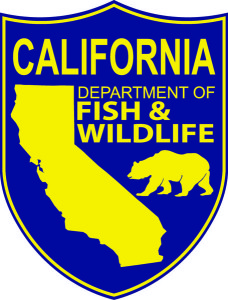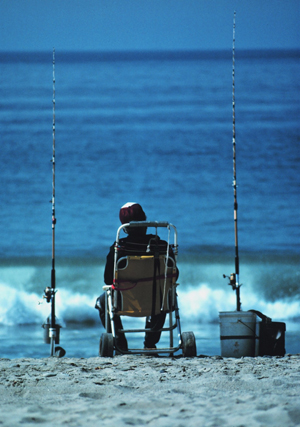Difference between revisions of "California Department of Fish and Wildlife (CDFW)"
(→Recreational Fishing) |
|||
| Line 48: | Line 48: | ||
*Project development/implementation | *Project development/implementation | ||
==Recreational Fishing== | ==Recreational Fishing== | ||
| + | [[File:Shorefisherman.jpg|300px|thumb|right|Saltwater recreational fishing [http://www.noaanews.noaa.gov/stories2011/20110222_saltwaterangling.html]]] | ||
CDFW is responsible for setting catch limits and publishing annual recreational fishing regulations. Separate regulations are available for ocean sport fishing <ref> https://www.wildlife.ca.gov/Fishing/Ocean/Regulations/Sport-Fishing </ref>, freshwater fishing <ref> https://www.wildlife.ca.gov/Fishing/Inland/2017-Regulations </ref>, and ocean sport fishing in Marine Protected Areas <ref> https://www.wildlife.ca.gov/Conservation/Marine/MPAs/Network </ref>. | CDFW is responsible for setting catch limits and publishing annual recreational fishing regulations. Separate regulations are available for ocean sport fishing <ref> https://www.wildlife.ca.gov/Fishing/Ocean/Regulations/Sport-Fishing </ref>, freshwater fishing <ref> https://www.wildlife.ca.gov/Fishing/Inland/2017-Regulations </ref>, and ocean sport fishing in Marine Protected Areas <ref> https://www.wildlife.ca.gov/Conservation/Marine/MPAs/Network </ref>. | ||
Revision as of 15:38, 2 April 2017
Need a page for California Department of Fish and Wildlife

Contents
Overview
The California Department of Fish and Wildlife (CDFW) is a state agency under the California Natural Resources Agency. The Department of Fish and Wildlife manages and protects the state's fish, wildlife, plant and native habitats. CDFW divides the State of California into seven management regions and is responsible for managing recreational, commercial, scientific, and educational uses. It also works to prevent illegal poaching.
History in California
California Department of Fish and Wildlife (CDFW) has a long history in California: [1]
- Pre 1851 - Spanish and Mexican game and fish laws applied
- 1850s - California's first official fish and game laws established to protect species such as: oysters elk, deer, salmon, and quail. Game laws are extended to all counties in California
- 1860s - First closed seasons for trout fishing established
- 1870s - Board of Fish commissioners is established, two of the first full-time game wardens are appointed, and the Fish commission authority is expanded to include game
- 1885 - First California fish and game laws published
- 1901 - Authority is expanded and game bag limits are set
- 1909 - Name changed to Fish and Game Commission following a greater emphasis placed on game laws
- 1913 - First year fishing licenses are required. New Law prevents the taking of sea otters
- 1920s - Reorganization of the Commission creates 3 new departments: fish culture, commercial fisheries, and patrol. Duties of the Fish and Game Commission taken over by the Division of Fish and Game (DFG)
- 1945 - A Constitutional amendment gives the Commission authority to make regulations for sport fishing and hunting
- 1950s - Five regional offices established. New branches include: Bureaus of Game, Conservation, Inland Fisheries, Patrol, and Marine Research. The Fish and Wildlife Coordination Act is enacted requiring consideration of DFG resources by state agencies when planning federal projects. Creation of The Water Projects Branch to monitor impacts of land use and water development projects on water quality.
- 1960s - DFG becomes part of the Resources of California agency. The Davis-Dolwig act enables DFG to be more influential to the State Water Project planning. A DFG water quality laboratory approved by legislature to work on projects affecting fish and wildlife. Anadromous fish Hatchery established.
- 1970s - the Endangered Species Act requires DFG to inventory the states threatened or endangered species. Multiple species populations are inventoried including sea otters and mountain lions. Drought in the late 70s require DFG to rescue and relocate threatened fish species. DFG releases new deer management limits in response to state legislation enacted to manage deer herds.
- 1980s - Caltip is created to enable citizens to report illegal taking of fish and game. DFGs wildlife education program begins to be taught in schools. An automated commercial fish tax system is started to monitor compliance. A randomized hunting tag system is started to divide up game tags distributed per year.
- 1990s - Aquaculture industry in California is placed first world-wide. First time a domesticated white sturgeon is spawned(federally listed). DFG becomes involved with oil spill response and prevention. Captive bred condors are released. DFG teams up with timber companies to restore fisheries and watershed resources. After the legislature passes the Marine Live Management Act, the DFG is required to set new commercial fishing regulations.
Responsibilities
- Recreational Fishing
- Hunting
- Commercial Fishing
- Education
- Project development/implementation
Recreational Fishing

CDFW is responsible for setting catch limits and publishing annual recreational fishing regulations. Separate regulations are available for ocean sport fishing [2], freshwater fishing [3], and ocean sport fishing in Marine Protected Areas [4].
California Recreational Fisheries Surveys (CRFS) and Recreational Fisheries Data (recFIN)[5] are both programs created to collect data on recreational fishing catches. This information is used to estimate catch rates and effort on a year to year basis, and can be used to update or change fishing regulations.
Regional Divisions
The Department of Fish and Wildlife divides the State of California into seven management regions. The Marine Region includes the entire coastline of California. The six terrestrial regions are delimited by county boundaries with the exception of the North Central Region and Bay Delta Region (Sacramento, Yolo, and San Joaquin counties).
- Northern Region: Del Norte, Humboldt, Lassen, Mendocino, Modoc, Shasta, Siskiyou, Tehama and Trinity counties.
- North Central Region: Alpine, Amador, Butte, Calaveras, Colusa, El Dorado, Glenn, Lake, Nevada, Placer, Plumas, Sacramento, San Joaquin, Sierra, Sutter, Yolo and Yuba counties.
- Bay Delta Region: Alameda, Contra Costa, Marin, Napa, Sacramento, San Mateo, Santa Clara, Santa Cruz, San Francisco, San Joaquin, Solano, Sonoma, and Yolo counties.
- Central Region: Fresno, Kern, Kings, Madera, Mariposa, Merced, Monterey, San Benito, San Luis Obispo, Stanislaus, Tulare and Tuolumne counties.
- South Coast Region: Los Angeles, Orange, San Diego, Santa Barbara and Ventura counties.
- Inland Deserts Region: Imperial, Inyo, Mono, Riverside and San Bernardino counties.
References
- ↑ Department of Fish and Game celebrates 130 years of serving California
- ↑ https://www.wildlife.ca.gov/Fishing/Ocean/Regulations/Sport-Fishing
- ↑ https://www.wildlife.ca.gov/Fishing/Inland/2017-Regulations
- ↑ https://www.wildlife.ca.gov/Conservation/Marine/MPAs/Network
- ↑ https://www.wildlife.ca.gov/Conservation/Marine/Groundfish/Recreational-Fishery-Data
Links
Disclaimer
This page may contain student work completed as part of assigned coursework. It may not be accurate. It does not necessary reflect the opinion or policy of CSUMB, its staff, or students.